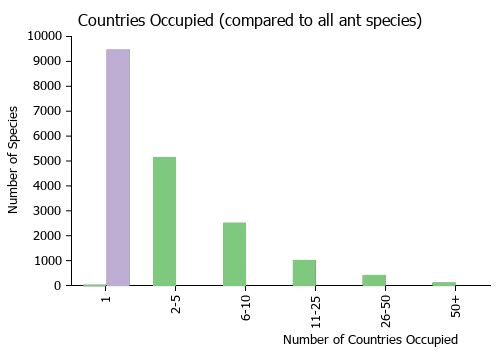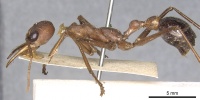Myrmecia vindex
| Myrmecia vindex | |
|---|---|

| |
| Scientific classification | |
| Kingdom: | Animalia |
| Phylum: | Arthropoda |
| Class: | Insecta |
| Order: | Hymenoptera |
| Family: | Formicidae |
| Subfamily: | Myrmeciinae |
| Tribe: | Myrmeciini |
| Genus: | Myrmecia |
| Species group: | gulosa |
| Species: | M. vindex |
| Binomial name | |
| Myrmecia vindex Smith, F., 1858 | |
| Synonyms | |
| |
These ants are visual predators. Typical encounters with even a solitary forager shows that they are a formidable and aggressive species. Nest workers are also always ready to rush out of their mound to attack an intruder (Heterick 2009).
Identification
Heterick (2009) - Myrmecia desertorum, Myrmecia fuscipes, Myrmecia gratiosa, Myrmecia nigriceps and Myrmecia vindex are all large to very large, reddish ants with red, brown or black heads and a black gaster.
Keys including this Species
Distribution
Latitudinal Distribution Pattern
Latitudinal Range: -28.25° to -35°.
| North Temperate |
North Subtropical |
Tropical | South Subtropical |
South Temperate |
- Source: AntMaps
Distribution based on Regional Taxon Lists
Australasian Region: Australia (type locality).
Distribution based on AntMaps
Distribution based on AntWeb specimens
Check data from AntWeb
Countries Occupied
| Number of countries occupied by this species based on AntWiki Regional Taxon Lists. In general, fewer countries occupied indicates a narrower range, while more countries indicates a more widespread species. |

|
Estimated Abundance
| Relative abundance based on number of AntMaps records per species (this species within the purple bar). Fewer records (to the left) indicates a less abundant/encountered species while more records (to the right) indicates more abundant/encountered species. |

|
Biology
Morphology
Myrmecia use their large eyes to locate prey and to find their way back to the nest from their foraging forays. Ogawa et al. (2015) were curious about how complex the color reception in ants may be and identified M. vindex as a good candidate for exploring this topic. They provided evidence about photoreceptors in M. vindex and Myrmecia croslandi that show ants can have sophisticated trichromatic color reception. Their abstract (Ogawa et al. 2015): Ants are thought to be special among Hymenopterans in having only dichromatic colour vision based on two spectrally distinct photoreceptors. Many ants are highly visual animals, however, and use vision extensively for navigation. We show here that two congeneric day- and night-active Australian ants have three spectrally distinct photoreceptor types, potentially supporting trichromatic colour vision. Electroretinogram recordings show the presence of three spectral sensitivities with peaks (lmax) at 370, 450 and 550 nm in the night-active Myrmecia vindex and peaks at 370, 470 and 510 nm in the day-active Myrmecia croslandi. Intracellular electrophysiology on individual photoreceptors confirmed that the night-active M. vindex has three spectral sensitivities with peaks (lmax) at 370, 430 and 550 nm. A large number of the intracellular recordings in the night-active M. vindex show unusually broad-band spectral sensitivities, suggesting that photoreceptors may be coupled. Spectral measurements at different temporal frequencies revealed that the ultraviolet receptors are comparatively slow. We discuss the adaptive significance and the probability of trichromacy in Myrmecia ants in the context of dim light vision and visual navigation.
Association with Other Organisms
 Explore: Show all Associate data or Search these data. See also a list of all data tables or learn how data is managed.
Explore: Show all Associate data or Search these data. See also a list of all data tables or learn how data is managed.
- This species is a host for the eucharitid wasp Austeucharis sp. (a parasitoid) (Quevillon, 2018) (multiple encounter modes; direct transmission; transmission outside nest).
Castes
Worker
Images from AntWeb
   
| |
| Syntype of Myrmecia vindex basirufa. Worker. Specimen code casent0907095. Photographer Z. Lieberman, uploaded by California Academy of Sciences. | Owned by MHNG, Geneva, Switzerland. |

| |
| Holotype of Myrmecia vindex. Worker. Specimen code casent0902796. Photographer Z. Lieberman, uploaded by California Academy of Sciences. | Owned by NHMUK, London, UK. |
Phylogeny
| Myrmecia |
| ||||||||||||||||||||||||||||||||||||||||||||||||||||||||||||||||||||||||||||||||||||||||||||||||||||||||||||||||||||||||||||||||||||||||||||||||||||||||||||||||||||||||||||||||||||||||||||||||||||||||||||||||||||||||||||||||||||||||||||||||||||||||||||||||||||||||||||||||||||||||||||||||||||||||||||||||||||||||||||||||||||||||||||||||||||||||||||||||||
Based on Mera-Rodríguez et al. (2023).
Nomenclature
The following information is derived from Barry Bolton's Online Catalogue of the Ants of the World.
- vindex. Myrmecia vindex Smith, F. 1858b: 144 (w.) AUSTRALIA (Western Australia).
- Type-material: holotype worker.
- Type-locality: Australia: West Australia, “42/19” (Moore).
- [Note: head detached, glued to label whose underside reads, “vindex type Sm.”]
- Type-depository: BMNH.
- Roger, 1861a: 34 (q.); Clark, 1925b: 143 (q.m.); Clark, 1951: 69 (ergatoid q.); Wheeler, G.C. & Wheeler, J. 1971d: 254 (l.).
- Status as species: Roger, 1861a: 34; Mayr, 1862: 725 (in key); Roger, 1863b: 22; Mayr, 1863: 431; Dalla Torre, 1893: 22; Forel, 1907h: 264; Emery, 1911d: 19; Poulton & Crawley, 1922: 119; Clark, 1925b: 143; Crawley, 1926: 376 (redescription); Wheeler, W.M. 1933i: 36; Clark, 1951: 67 (redescription); Douglas & Brown, 1959: 14; Haskins & Haskins, 1974: 258; Kugler, C. 1980b: 265; Taylor & Brown, 1985: 17; Taylor, 1987a: 46; Ogata, 1991a: 358; Ogata & Taylor, 1991: 1638 (in key), 1661; Bolton, 1995b: 273; Heterick, 2009: 121.
- Senior synonym of basirufa: Ogata & Taylor, 1991: 1661; Bolton, 1995b: 273.
- Distribution: Australia.
- basirufa. Myrmecia vindex var. basirufa Forel, 1907h: 264 (w.) AUSTRALIA (Western Australia).
- Type-material: syntype workers (number not stated).
- Type-locality: Australia: Western Australia, Subiaco, Stat. 109, 1905 (W. Michaelsen & R. Hartmeyer).
- Type-depositories: ANIC, MHNG.
- Clark, 1951: 71 (q.m.).
- Subspecies of vindex: Emery, 1911d: 19; Clark, 1951: 70 (redescription); Taylor & Brown, 1985: 17; Taylor, 1987a: 46; Ogata, 1991a: 358.
- Junior synonym of vindex: Ogata & Taylor, 1991: 1661; Bolton, 1995b: 270.
Type Material
- Syntype, 1 worker, Subiaco, Western Australia, Australia, Hamburg SW Aust. Exped., ANIC32-014846, Australian National Insect Collection.
- Syntype, worker(s), Western Australia, Australia, The Natural History Museum.
- Syntype, 1 worker, Subiaco, Western Australia, Australia, Museum of Comparative Zoology.
- Syntype, worker(s), Subiaco, Western Australia, Australia, Musee d'Histoire Naturelle Genève.
The following notes on F. Smith type specimens have been provided by Barry Bolton (details):
Myrmecia vindex
Holotype worker in The Natural History Museum. Labelled “W. Austral 42/19” and with “Mr Moor” on underside of label.
At some time in the past the head has become detached and is now glued to a label whose underside reads “vindex type Sm.”
Description
Karyotype
- See additional details at the Ant Chromosome Database.
 Explore: Show all Karyotype data or Search these data. See also a list of all data tables or learn how data is managed.
Explore: Show all Karyotype data or Search these data. See also a list of all data tables or learn how data is managed.
- 2n = 74 (Australia) (Hirai et al., 1996).
- 2n = 76 (Australia) (Hirai et al., 1996).
References
- Ataya, H., Lenoir, A. 1984. Le comportement necrophorique chez la formi Lasius niger L. Insectes Sociaux 31: 20-33.
- Billen, J., Khalife, A., Ito, F., Anh, N.D., Esteves, F.A. 2021. The basitarsal sulcus gland, a novel exocrine structure in ants. Arthropod Structure, Development 61, 101041 (doi:10.1016/j.asd.2021.101041).
- Clark, J. 1925b. The ants of Victoria. Part II. Vic. Nat. (Melb.). 42:135-144. (page 143, queen, male described)
- Clark, J. 1951. The Formicidae of Australia. 1. Subfamily Myrmeciinae: 230 pp. CSIRO, Melbourne. [(31.xii).1951.]
- Crawley, W. C. 1926. A revision of some old types of Formicidae. Trans. Entomol. Soc. Lond. 1925:373-393 (page 376, see also)
- Douglas, A.; Brown, W. L., Jr. 1959. Myrmecia inquilina new species: the first parasite among the lower ants. Insectes Soc. 6:13-19. (page 14, see also)
- Forel, A. 1907j. Formicidae. In: Michaelsen, W., Hartmeyer, R. (eds.) Die Fauna Südwest-Australiens. Band I, Lieferung 7. Jena: Gustav Fischer, pp. 263-310. (page 264, see also)
- Haskins, C. P.; Haskins, E. F. 1974. Notes on the necrophoric behaviour in the archaic ant Myrmecia vindex. Psyche. 81:258-267. (page 258, see also)
- Heterick, B. E. 2009. A guide to the ants of South-western Australia. Records of the Western Australian Museum, Supplement 76:1-206.
- Heterick, B.E. 2021. A guide to the ants of Western Australia. Part I: Systematics. Records of the Western Australian Museum, Supplement 86, 1-245 (doi:10.18195/issn.0313-122x.86.2021.001-245).
- Heterick, B.E. 2022. A guide to the ants of Western Australia. Part II: Distribution and biology. Records of the Western Australian Museum, supplement 86: 247-510 (doi:10.18195/issn.0313-122x.86.2022.247-510).
- Mera-Rodríguez, D., Jourdan, H., Ward, P.S., Shattuck, S., Cover, S.P., Wilson, E.O., Rabeling, C. 2023. Biogeography and evolution of social parasitism in Australian Myrmecia bulldog ants revealed by phylogenomics. Molecular Phylogenetics and Evolution 186, 107825 (doi:10.1016/j.ympev.2023.107825).
- Ogata, K.; Taylor, R. W. 1991. Ants of the genus Myrmecia Fabricius: a preliminary review and key to the named species (Hymenoptera: Formicidae: Myrmeciinae). J. Nat. Hist. 2 25:1623-1673. (page 1661, Senior synonym of basirufa)
- Ogawa, Y., M. Falkowski, A. Narendra, J. Zeil, and J. M. Hemmi. 2015. Three spectrally distinct photoreceptors in diurnal and nocturnal Australian ants. Proceedings of the Royal Society of London B: Biological Sciences. 282:20150673. doi:10.1098/rspb.2015.0673
- Roger, J. 1861a. Die Ponera-artigen Ameisen (Schluss). Berl. Entomol. Z. 5:1-54. (page 34, queen described)
- Smith, F. 1858b. Catalogue of hymenopterous insects in the collection of the British Museum. Part VI. Formicidae. London: British Museum, 216 pp. (page 144, worker described)
- van der Kooi, C.J., Stavenga, D.G., Arikawa, K., Belušič, G., Kelber, A. 2020. Evolution of insect color vision: From spectral sensitivity to visual ecology. Annual Review of Entomology 66, annurev-ento-061720–071644. (doi:10.1146/annurev-ento-061720-071644).
- Wheeler, G. C.; Wheeler, J. 1971d. Ant larvae of the subfamily Myrmeciinae (Hymenoptera: Formicidae). Pan-Pac. Entomol. 47:245-256. (page 254, larva described)
References based on Global Ant Biodiversity Informatics
- Forel A. 1915. Results of Dr. E. Mjöbergs Swedish Scientific Expeditions to Australia 1910-13. 2. Ameisen. Ark. Zool. 9(16): 1-119
- Ogata K. and Taylor R.W. 1991. Ants of the genus Myrmecia Fabricius: a preliminary review and key to the named species (Hymenoptera: Formicidae: Myrmeciinae), Journal of Natural History, 25: 1623-1673
- Pages using DynamicPageList3 parser function
- Pages using duplicate arguments in template calls
- South subtropical
- South temperate
- Eucharitid wasp Associate
- Host of Austeucharis sp.
- ANIC specimen
- Karyotype
- Species
- Extant species
- Formicidae
- Myrmeciinae
- Myrmeciini
- Myrmecia
- Myrmecia vindex
- Myrmeciinae species
- Myrmeciini species
- Myrmecia species
- Need Body Text

